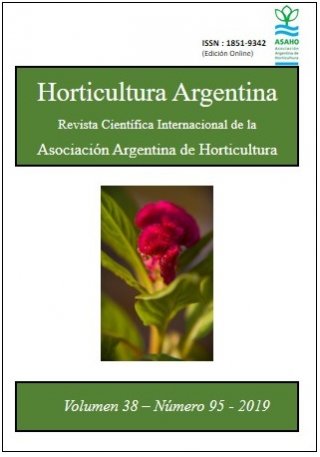Ver ítem
- xmlui.general.dspace_homeCentros Regionales y EEAsCentro Regional Patagonia NorteEEA Valle Inferior del Río NegroArtículos científicosxmlui.ArtifactBrowser.ItemViewer.trail
- Inicio
- Centros Regionales y EEAs
- Centro Regional Patagonia Norte
- EEA Valle Inferior del Río Negro
- Artículos científicos
- Ver ítem
Influencia del cultivo antecesor sobre la comunidad de malezas en cebolla de siembra directa = Influence of the fore crop on weeds community in direct seeding onion
Resumen
Las plantas de cebolla (Allium cepa L.) presentan baja capacidad competitiva frente a las malezas por lo que éstas deben ser controladas desde el inicio del cultivo. Por otro lado, las comunidades vegetales responden de manera diferente a las prácticas de manejo empleadas en los cultivos antecesores (ej. laboreo y fertilización). El objetivo fue evaluar el efecto de diferentes cultivos antecesores sobre las comunidades de malezas en cultivos de cebolla de
[ver mas...]
Las plantas de cebolla (Allium cepa L.) presentan baja capacidad competitiva frente a las malezas por lo que éstas deben ser controladas desde el inicio del cultivo. Por otro lado, las comunidades vegetales responden de manera diferente a las prácticas de manejo empleadas en los cultivos antecesores (ej. laboreo y fertilización). El objetivo fue evaluar el efecto de diferentes cultivos antecesores sobre las comunidades de malezas en cultivos de cebolla de siembra directa. Durante la temporada 2015/16 se implantó un cultivo de cebolla por siembra directa en parcelas con diferentes cultivos antecesores: tomate, soja, maíz y zanahoria en el Valle Inferior del río Negro. La emergencia de malezas se evaluó 15 y 45 días después de la siembra (DDS). Se recogieron las malezas presentes sobre el bordo en un marco de 30 x 30 cm para determinar el número y la biomasa para cada especie, y calcular la riqueza y diversidad. Se observaron diez especies de malezas en estado cotiledonal a los 15 DDS, sin diferencias entre tratamientos. A los 45 DDS, Lamium amplexicaule L., Xanthium spinosum L., Polygonum aviculare L., Picris echioides L., Sonchus asper L. y Echinochloa crus-galli L., fueron las especies más frecuentes. La mayor riqueza, densidad y diversidad se observó después de la rotación con tomate. La respuesta diferencial de las malezas al cultivo antecesor permitiría planificar las rotaciones para un control más eficiente de las mismas en el cultivo de cebolla.
[Cerrar]
Onion plants (Allium cepa L.) have a low
competitive capacity against weeds, so
these must be controlled from the
beginning of the crop cycle. Plant
communities respond differently to the
management practices used in the fore
crops (eg. tillage and fertilization). The
objective was to evaluate the effect of
different fore crops on the weed
communities in direct seeding onion crops.
During the 2015/16 season, an onion crop was implanted in the
[ver mas...]
Onion plants (Allium cepa L.) have a low
competitive capacity against weeds, so
these must be controlled from the
beginning of the crop cycle. Plant
communities respond differently to the
management practices used in the fore
crops (eg. tillage and fertilization). The
objective was to evaluate the effect of
different fore crops on the weed
communities in direct seeding onion crops.
During the 2015/16 season, an onion crop was implanted in the Lower Valley of the
Rio Negro by direct seeding in plots with
different fore crops: tomato, soybean, corn
and carrot. The emergence of weeds was
evaluated 15 and 45 days after sowing
(DAS). The weeds on the ridge were
collected in a 30 x 30 cm frame to
determine the number and biomass for
each species, and to calculate the richness
and diversity. Ten weed species were
observed in a cotyledonal state at 15 DAS,
without differences between treatments. At
45 DAS, Lamium amplexicaule L.,
Xanthium spinosum L., Polygonum
aviculare L., Picris echinoides L.,
Sonchusasper L. and Echinochloa crusgalli L. were the most frequent species.
The greatest richness, density and diversity was observed after rotation with tomato.
The differential response of the weeds to
the fore crops would help design the
rotations for more efficient weed control in
an onion crop.
[Cerrar]

Autor
Avilés, Lucrecia María;
Baffoni, Patricia Andrea;
Gajardo, Omar Ariel;
Alarcon, Aldo José;
Doñate, Maria Teresa;
Cañón, Silvia Liliana;
Bezic, Carlos Rubén;
Sidoti Hartmann, Brunilda;
Fecha
2019-04-29
Editorial
ASAHO
ISSN
1851-9342
Documentos Relacionados
Formato
pdf
Tipo de documento
artículo
Proyectos
(ver más)
INTA/PATNOR/1281308/AR./Contribución al desarrollo territorial de la zona atlántica de Río Negro.
Palabras Claves
Derechos de acceso
Abierto
 Excepto donde se diga explicitamente, este item se publica bajo la siguiente descripción: Creative Commons Attribution-NonCommercial-ShareAlike 2.5 Unported (CC BY-NC-SA 2.5)
Excepto donde se diga explicitamente, este item se publica bajo la siguiente descripción: Creative Commons Attribution-NonCommercial-ShareAlike 2.5 Unported (CC BY-NC-SA 2.5)


